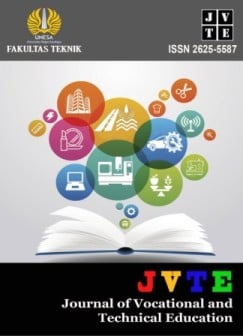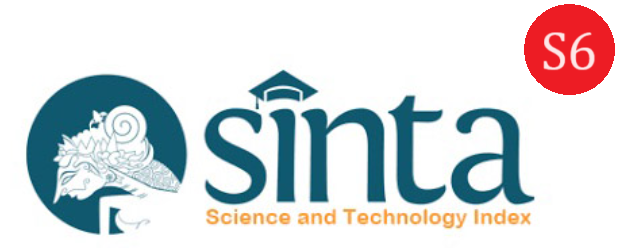Analisis Penggunaan GPT dalam Pembelajaran Klinik Optik I di ARO Gapopin
DOI:
https://doi.org/10.26740/jvte.v7n2.p24-31Keywords:
GPT, kecerdasan buatan, pembelajaran klinik optik, efektivitas pembelajaranAbstract
Perkembangan teknologi kecerdasan buatan (Artificial Intelligence/AI), khususnya model bahasa besar seperti Generative Pre-trained Transformer (GPT), telah membawa transformasi besar dalam pendekatan pembelajaran di bidang pendidikan vokasi, termasuk optometri. GPT memberikan kemampuan untuk menghasilkan respons berbasis konteks, menjelaskan konsep sulit, serta memberikan contoh penerapan praktis secara cepat dan interaktif. Penelitian ini bertujuan untuk menganalisis intensitas dan efektivitas penggunaan GPT dalam pembelajaran mata kuliah Klinik Optik I di Akademi Refraksi Optisi dan Optometry (ARO) Gapopin. Penelitian ini menggunakan pendekatan kuantitatif deskriptif dengan melibatkan 30 responden mahasiswa dari dua kelas yang memiliki rentang usia 19 hingga 52 tahun. Instrumen penelitian berupa kuesioner skala Likert lima tingkat yang menilai intensitas, persepsi, dan dampak penggunaan GPT terhadap efektivitas belajar. Data dianalisis melalui perhitungan rata-rata, persentase, dan korelasi antar variabel. Hasil penelitian menunjukkan bahwa penggunaan GPT memiliki dampak positif yang signifikan terhadap efektivitas pembelajaran, dengan skor rata-rata 3,17 dari 4 yang termasuk kategori efektif. GPT terbukti membantu mahasiswa memahami topik kompleks seperti karakteristik fisik dan optik bahan lensa serta efek prisma, sekaligus meningkatkan kemandirian belajar dan rasa percaya diri dalam latihan klinis. Secara keseluruhan, GPT berperan sebagai asisten digital adaptif yang tidak hanya mempermudah akses informasi, tetapi juga mendorong pembelajaran reflektif dan personal. Efektivitas GPT akan semakin optimal apabila diintegrasikan secara berkelanjutan dalam desain instruksional dan didukung peningkatan literasi digital mahasiswa.
The rapid advancement of Artificial Intelligence (AI) technologies, particularly large language models such as Generative Pre-trained Transformer (GPT), has brought significant transformation to instructional approaches in vocational education, including the field of optometry. GPT provides capabilities for generating contextual responses, explaining complex concepts, and offering practical examples interactively and efficiently. This study aims to analyze the intensity and effectiveness of GPT utilization in the Clinical Optics 1 course at the Akademi Refraksi Optisi dan Optometry (ARO) Gapopin. A quantitative descriptive approach was employed involving 30 student respondents from two classes aged between 19 and 52 years. The research instrument used a five-point Likert-scale questionnaire assessing usage intensity, perceptions, and the impact of GPT on learning effectiveness. Data were analyzed using mean scores, percentage distributions, and correlation analyses. The findings indicate that GPT has a significant positive effect on learning effectiveness, achieving an average score of 3.17 out of 4, categorized as “effective.” GPT was found to assist students in understanding complex topics such as the physical and optical characteristics of lens materials and prismatic effects, while also enhancing independent learning and confidence in clinical exercises. Overall, GPT serves not merely as an informational tool but as an adaptive digital learning assistant that supports reflective and personalized learning. Its effectiveness can be further optimized through sustained integration into instructional design and improved student digital literacy.
References
[1] R. Luckin, “AI and Education: The Importance of Teacher Guidance,” Brit. J. Educ. Technol., vol. 54, no. 2, pp. 254–262, Feb. 2023.
[2] W. Holmes, M. Bialik, and C. Fadel, Artificial Intelligence in Education: Promise and Implications for Teaching and Learning. Paris, France: UNESCO Publishing, 2022.
[3] OpenAI, GPT-4 Technical Report. San Francisco, CA, USA: OpenAI, 2024.
[4] E. Kasneci, F. Sessler, S. Kühn, T. R. Kasneci, and M. Bannert, “ChatGPT for Good? On Opportunities and Challenges of Large Language Models for Education,” Learn. Individ. Differ., vol. 103, pp. 102274, Apr. 2023.
[5] M. Y. Khan and M. Rafiq, “AI and the Future of Education: A Systematic Review of GPT Models,” Educ. Artif. Intell. Rev., vol. 2, no. 1, pp. 13–28, Jan. 2024.
[6] S. Alshahrani, “AI-Driven Learning Personalization in Vocational Education,” Int. J. Educ. Technol., vol. 20, no. 4, pp. 65–79, Dec. 2023.
[7] T. Susanti and D. Darmawan, “Pemanfaatan Chatbot Berbasis AI dalam Pembelajaran Mandiri,” J. Teknol. Pendidik. Indones., vol. 10, no. 3, pp. 221–233, 2022.
[8] R. Hutapea and J. Siahaan, “Kendala Pembelajaran Praktik Klinik pada Pendidikan Refraksi Optisi,” J. Optometri Indones., vol. 5, no. 2, pp. 44–52, 2021.
[9] P. Jayasuriya, R. Deshpande, and K. O’Neill, “Understanding Optical Principles in Vocational Optome-try Education,” J. Vis. Sci. Educ., vol. 12, no. 1, pp. 25–33, 2020.
[10] A. Gupta, P. Sharma, and R. Singh, “The Role of ChatGPT in Higher Education: Opportunities and Challenges,” Educ. Inf. Technol., vol. 28, no. 5, pp. 5433–5451, 2023.
[11] O. Zawacki-Richter, M. Marín, M. Bond, and F. Gouverneur, “Systematic Review of Research on Artificial Intelligence Applications in Higher Education,” Int. J. Educ. Technol. High. Educ., vol. 16, no. 39, pp. 1–27, 2019.
[12] C. Huang, X. Zhang, and D. Wang, “Student Engagement and AI Tools: Risks and Potentials,” Com-put. Educ., vol. 207, pp. 104879, 2023.
[13] J. Tang and W. Chen, “Critical Thinking and AI Support in Higher Education,” Comput. Hum. Be-hav. Rep., vol. 15, pp. 101399, 2024.
[14] S. Wardani and N. Rahayu, “Integrasi Teknologi AI dalam Pembelajaran Vokasi,” J. Inov. Pendidik. Teknol., vol. 7, no. 1, pp. 19–29, 2022.
[15] B. S. Bloom, Taxonomy of Educational Objectives: The Classification of Educational Goals. New York, NY, USA: David McKay Co., 1956.
[16] Sugiyono, Metode Penelitian Kuantitatif, Kualitatif, dan R&D. Bandung, Indonesia: Alfabeta, 2019.
[17] J. W. Creswell, Research Design: Qualitative, Quantitative, and Mixed Methods Approaches, 5th ed. Thousand Oaks, CA, USA: SAGE Publications, 2018.
[18] J. R. Fraenkel, N. E. Wallen, and H. H. Hyun, How to Design and Evaluate Research in Education, 10th ed. New York, NY, USA: McGraw-Hill Education, 2019.
[19] R. Hutapea and J. Siahaan, “Kendala Pembelajaran Praktik Klinik pada Pendidikan Refraksi Optisi,” J. Optometri Indones., vol. 5, no. 2, pp. 44–52, 2021.
[20] S. Arikunto, Prosedur Penelitian: Suatu Pendekatan Praktik, 9th ed. Jakarta, Indonesia: Rineka Cipta, 2020.
[21] N. Purwanto, Prinsip-prinsip dan Teknik Evaluasi Pengajaran, 5th ed. Bandung, Indonesia: Remaja Rosdakarya, 2021.
[22] H. N. Boone and D. A. Boone, “Analyzing Likert Data,” J. Extension, vol. 50, no. 2, pp. 1–5, Apr. 2012.
[23] D. A. Dillman, J. D. Smyth, and L. M. Christian, Internet, Phone, Mail, and Mixed-Mode Surveys: The Tailored Design Method, 4th ed. Hoboken, NJ, USA: Wiley, 2014.
[24] J. Cohen and P. Cohen, Applied Multiple Regression/Correlation Analysis for the Behavioral Sci-ences, 3rd ed. New York, NY, USA: Routledge, 2013.
[25] I. Ghozali, Aplikasi Analisis Multivariate dengan Program IBM SPSS 25, 9th ed. Semarang, Indone-sia: Badan Penerbit Universitas Diponegoro, 2018.
Downloads
Published
How to Cite
Issue
Section
License

This work is licensed under a Creative Commons Attribution-NonCommercial-ShareAlike 4.0 International License.
 Abstract views: 71
,
Abstract views: 71
, PDF Downloads: 36
PDF Downloads: 36






